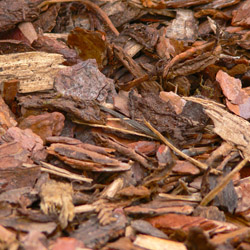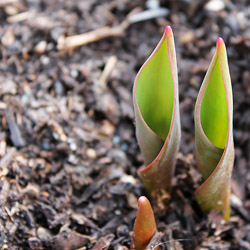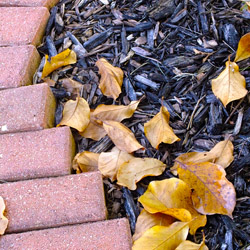Mulch can add a protective layer to any fall garden, flowerbeds, or shrubs, but is it best for your landscape? Understanding the pros and cons of fall mulching can help you better prepare all your plants for the changing season.
Benefits of Fall Mulching
There’s no denying that when done properly, mulching in fall can provide enormous benefits to the landscape. The biggest pros of fall mulching include:
- Insulating the soil.
Fall mulching preserves heat that will keep microbes, earthworms, and other life active and thriving in the soil longer to improve the soil condition. The insulation mulch provides will also help moderate temperature swings that can damage tender roots, especially those of newly planted plant material. - Saving time with spring chores.
Spring is a hectic season in the garden, but if mulching is already done in the fall, it doesn’t need to be redone in the spring and there will be more time to spend with other planting and gardening tasks when the weather warms. - Easier climate for working.
The milder temperatures of autumn make it more enjoyable to spend time outdoors with the heavy labor of spreading mulch. This is especially true if you will be mulching multiple flowerbeds, tree rings, borders, and other spaces throughout the landscape. - Simpler to spread.
If you mulch in spring, you may need to be delicately working around emerging sprouts and blooming bulbs. In fall, however, the work is less delicate after beds have already been cleaned out, and you can spread mulch much more quickly and efficiently. - Weed suppression.
Weeds don’t stop growing when summer ends, and just like spring mulching, spreading mulch in fall will help minimize weeds. This will make it easier to keep weeds under control when spring arrives again, and growth is renewed. - Preventing soil erosion.
Soils on sloped beds can quickly erode in autumn and winter weather as rain and snow batter the slopes. A good layer of mulch will protect the soil and keep it in place throughout the season, so it is ready to work again in the spring. - Nourishing the soil.
Organic mulches that are spread in autumn will have several months to settle and begin decaying. This will introduce more nutrients into the top layer of soil, so it is richer and healthier for spring planting. - Tidy Appearance
A fresh layer of mulch will always make the landscape and garden look well-tended.
Problems With Fall Mulching
While fall mulching can be very beneficial to the landscape, it may not be the best choice for your gardens. Potential cons of fall mulching include:
- Stopping self-sowers.
Any herbs or flowers that would normally self-sow as seeds ripen will be inhibited by a layer of autumn mulch, and the yield for new growth in the spring will be significantly reduced. The thicker the mulch, the fewer seeds will germinate. - Time constraints of shorter days.
While the autumn climate may be perfect for big mulching jobs, shorter days and the risk of early snows or freezes can make it difficult to complete the undertaking. If the mulching is started too late in the season, it may not get finished before winter begins. - Loss of winter interest landscaping.
One benefit of fall mulching is that it is easier to spread the mulch over already pruned perennial beds. This same step, however, requires pruning perennial stems back which removes that winter interest from the landscape as it takes away stems, berries, and seeds that winter wildlife may have needed. - Attracting unwanted pests.
A deep layer of fresh mulch can be very attractive to unwelcomed fall and winter guests, including rodents and slugs that will burrow into the mulch and make themselves at home until spring. This problem can be minimized by taking care not to use too much mulch in autumn. - Depriving roots of oxygen.
While fall mulch will help moderate soil temperatures to protect delicate roots, a thick layer may also stifle airflow into the soil and deprive roots of essential oxygen. At the same time, excess moisture that accumulates under a thick mulch layer could lead to problems as well. Be sure to keep your fall mulching to no more than 2 inches deep from plant stem to the dripline. - Fading before spring.
Once fall mulch is laid, it will begin decomposing and could lose its sharp color and freshness long before spring arrives. This can be fixed simply by turning the mulch in the spring to refresh the layer even as new bulbs and shoots are starting to pop up to greet the season.
Fall Mulching Tips
Every gardener must decide when to mulch, and if you do want to take advantage of the benefits of fall mulching, doing so carefully can help prevent many of the cons. First, adjust the mulch depth to match the requirements of your local climate and plant needs – a layer 2-4 inches deep is typically adequate. Apply fall mulch after the first hard freeze when perennials can be cut back easily but take care not to pile it against tree trunks or shrub bases where it may invite gnawing pests or induce bark rot.
Mulching can be a very productive fall chore for flowerbeds, garden spaces, borders, and other parts of the landscape. It has to potential to save you time and energy and help keep your property looking its very best not only in autumn, but through the winter and into spring once again.






